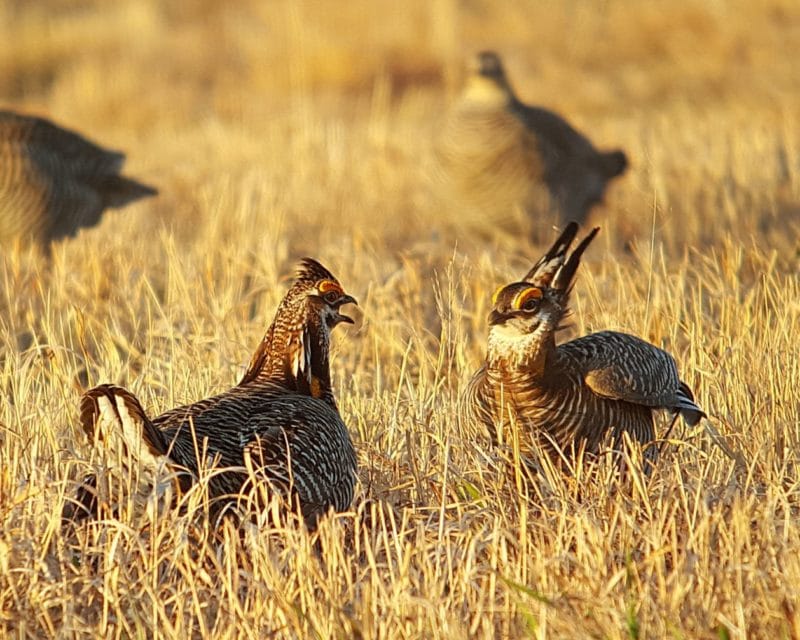Overview
The Grassland Community Collaborative (GCC) was formed in 2005 through the National Wind Coordinating Collaborative (NWCC) and oversaw a comprehensive seven-year research project led by Drs. Brett Sandercock and Samantha Wisely on the effects of wind power development on Greater Prairie-Chicken.
To read about the key findings from the comprehensive seven-year research project led by Drs. Brett Sandercock and Samantha Wisely on the effects of wind power development on Greater Prairie-Chickens, please view the Research Brief. The research project was overseen by the Grassland Community Collaborative (read below for more details on the GCC). Access the press release for the research report here.
View All NWCC & REWI Results on Prairie Grouse and Wind Energy
Visit the Results Catalog
Summary of Findings
Greater Prairie-Chicken populations have declined, primarily from loss of their prairie habitat to agriculture and other human development. As wind energy projects are proposed in Kansas and other states where Greater Prairie-Chickens and other grassland birds are now of conservation concern, conservationists, wildlife agencies, and wind energy companies are collaborating to study possible impacts from such development. Results from a comprehensive seven-year research project in Kansas suggest that wind power does not strongly affect Greater Prairie-Chickens. While weak negative effects were observed in male attendance of leks (communal display sites), female survival showed a positive trend. Little to no impacts were observed on most of the demographic parameters studied. The strongest correlates of population performance were the availability of native prairie and vegetative cover at the nest site. Efforts to improve rangeland management and to reduce predation would aid in the recovery of Greater Prairie-Chicken populations.
Grassland Community Collaborative

The Grassland Community Collaborative (GCC) brought together stakeholders to: 1) identify critical research questions related to grassland community species; 2) secure and administer cooperative funding to conduct research; 3) encourage peer-reviewed collaborative research; and 4) identify both potential impacts and mitigation strategies to address any impacts.
The GCC activities were overseen by an Oversight Committee that was charged with: approving research proposals and what individuals and institutions conduct the research; reviewing and approving communications to the public; contributing strategic direction; providing advice on raising funds; and approving the annual workplan and products of GCC.
Peer-Reviewed Publications
Winder, V.L., A.J. Gregory, L.B. McNew, and B.K. Sandercock. 2015. Responses of male Greater Prairie-Chickens to wind energy development. The Condor, 117(2):284-296.
McNew, L.B., L.M. Hunt, A.J. Gregory, S.M. Wisely, and B.K. Sandercock. 2014. Effects of wind energy development on the nesting ecology of Greater Prairie-Chickens in fragmented grasslands. Conservation Biology, 28:1089-1099.
Winder, V.L., L.B. McNew, A.J. Gregory, L.M. Hunt, S.M. Wisely, and B.K. Sandercock. 2014. Space use of female Greater Prairie-Chickens in response to wind energy development. Ecosphere, 5:art3.
Winder, V.L., L.B. McNew, A.J. Gregory, L.M. Hunt, S.M. Wisely, and B.K. Sandercock. 2014. Effects of wind energy development on the survival of Greater Prairie-Chickens. Journal of Applied Ecology, 51:395-405.
Blanco-Fontao, B., J.R. Obeso, M. Quevedo, L.B. McNew, and B.K. Sandercock. 2013. Effects of sexual dimorphism and habitat composition on the trophic behavior of Greater Prairie-Chickens revealed through analysis of stable isotopes. PLoS One, 8(11): e79986.
McNew, L.B., A.J. Gregory, and B.K. Sandercock. 2013. Spatial heterogeneity in habitat selection: nest site selection by Greater Prairie-Chickens. Journal of Wildlife Management, 77:791-801. DOI: 10.1002/jwmg.493
McNew, L.B., A.J. Gregory, S.M. Wisely, and B.K. Sandercock. 2012. Demography of Greater Prairie-Chickens: regional variation in vital rates, sensitivity values, and population dynamics. Journal of Wildlife Management, 76:987-1000. DOI: 10.1002/jwmg.369: Received national award for the best journal article from The Wildlife Society.
Gregory, A.J., L.B. McNew, T.J. Prebyl, B.K. Sandercock, and S.M. Wisely. 2011. Hierarchical modeling of lek habitats of Greater Prairie-Chickens. Studies in Avian Biology, 39:21-32.
McNew, L.B., A.J. Gregory, S.M. Wisely, and B.K. Sandercock. 2011a. Reproductive biology of a southern population of Greater Prairie-Chickens. Studies in Avian Biology, 39:209-221.
McNew, L.B., A.J. Gregory, S.M. Wisely, and B.K. Sandercock. 2011b. Human-mediated selection on life-history traits of Greater Prairie-Chickens. Studies in Avian Biology, 39:255-266.
Completed Dissertations
Gregory, A.J. 2011. Landscape genetics and behavioral ecology of Greater Prairie-Chickens (Tympanuchus cupido). Ph.D. dissertation, Kansas State University, 159 pages.
McNew, L.B. 2010. An analysis of Greater Prairie-Chicken demography in Kansas: the effects of human land use on the population ecology of an obligate grassland species. Ph.D. dissertation, Kansas State University, 149 pages.
Archive

Press Release: Researchers Investigate
Causes of Population Declines of Prairie Chickens in Kansas
October 27, 2010
Overview of the Grassland and Shrub Steppe Species Collaborative (GS3C)
April 29, 2008
Press Release: Study Underway on the Effects of Wind Power on Prairie-Chicken Demography and Population Genetics
July 30, 2007
GS3 Subgroup Initial Meeting
March 29-30, 2005 – Wichita, KS